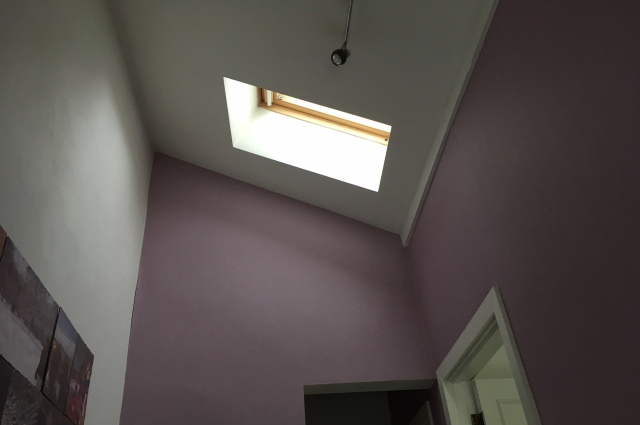Rooflight
Windows are openings fitted with glass to admit light and allow people to see out. They are often openable to allow ventilation. Rooflights (sometimes described as ‘roof lights’ or ‘skylights’) are windows built into the roof of a building.
Approved Document B2, ‘Fire safety: Buildings other than dwellinghouses’, defines a rooflight as:
| A dome light, lantern light, skylight, ridge light, glazed barrel vault or other element to admit daylight through a roof. |

|

|
Rooflights are effective at allowing natural light deep into the centre of a building, particularly where it is not possible to install windows in perimeter walls or where privacy is needed. Where they are openable, they can also be effective at promoting natural ventilation, as they tend to be at the top of buildings and so can benefit from the stack effect. They may also be used to allow access to roofs or to roof terraces.
Some rooflights however can be seen as a poor design solution, contributing little to the architectural form of a building, and simply creating a hole in a roof because without them there would be insufficient natural light. They can also suffer from ponding, dirt accumulation and staining.
Rooflights must have safety glazing, and if they are out of reach, may need a mechanism or motor to open them.
In some areas, some rooflights may be considered a permitted developments, not requiring planning permission. However, it is sensible to consult with the local planning authority to check this.
BS EN 14351-1 (Windows and doors. Product standard, performance characteristics. Windows and external pedestrian doorsets) suggests that the term ‘roof window’ refers to a window that is in the same plane as the surrounding roof, and has a minimum pitch of 15 degrees. This is as opposed to 'rooflights' which by this definition are installed on an upstand, and so are not in the same plane as the surrounding roof.
[edit] Related articles on Designing Buildings
- Aspects of daylighting design covered by EN 17037.
- Conservation rooflights.
- Designing daylight solutions for commercial buildings.
- Display window.
- Domestic windows.
- Dormer window.
- Double glazing.
- Easily accessible window.
- EN 17037 Daylight in buildings.
- Glass.
- Glazier.
- Glazing.
- How to waterproof a rooflight.
- Large rooflights.
- Light well.
- Rights to light.
- R-value.
- Secondary glazing.
- Steel framed rooflights.
- Structural glass assembly.
- Types of building EN 17037 applies to.
- U-What?
- Velux window.
- Window energy rating.
- Window.
Featured articles and news
The Building Safety Forum at the Installershow 2025
With speakers confirmed for 24 June as part of Building Safety Week.
The UK’s largest air pollution campaign.
Future Homes Standard, now includes solar, but what else?
Will the new standard, due to in the Autumn, go far enough in terms of performance ?
BSRIA Briefing: Cleaner Air, Better tomorrow
A look back at issues relating to inside and outside air quality, discussed during the BSRIA briefing in 2023.
Restoring Abbotsford's hothouse
Bringing the writer Walter Scott's garden to life.
Reflections on the spending review with CIAT.
Retired firefighter cycles world to raise Grenfell funds
Leaving on 14 June 2025 Stephen will raise money for youth and schools through the Grenfell Foundation.
Key points for construction at a glance with industry reactions.
Functionality, visibility and sustainability
The simpler approach to specification.
Architects, architecture, buildings, and inspiration in film
The close ties between makers and the movies, with our long list of suggested viewing.
SELECT three-point plan for action issued to MSPs
Call for Scottish regulation, green skills and recognition of electrotechnical industry as part of a manifesto for Scottish Parliamentary elections.
UCEM becomes the University of the Built Environment
Major milestone in its 106-year history, follows recent merger with London School of Architecture (LSE).
Professional practical experience for Architects in training
The long process to transform the nature of education and professional practical experience in the Architecture profession following recent reports.
A people-first approach to retrofit
Moving away from the destructive paradigm of fabric-first.
International Electrician Day, 10 June 2025
Celebrating the role of electrical engineers from André-Marie Amperè, today and for the future.
New guide for clients launched at Houses of Parliament
'There has never been a more important time for clients to step up and ...ask the right questions'
The impact of recycled slate tiles
Innovation across the decades.
EPC changes for existing buildings
Changes and their context as the new RdSAP methodology comes into use from 15 June.

























